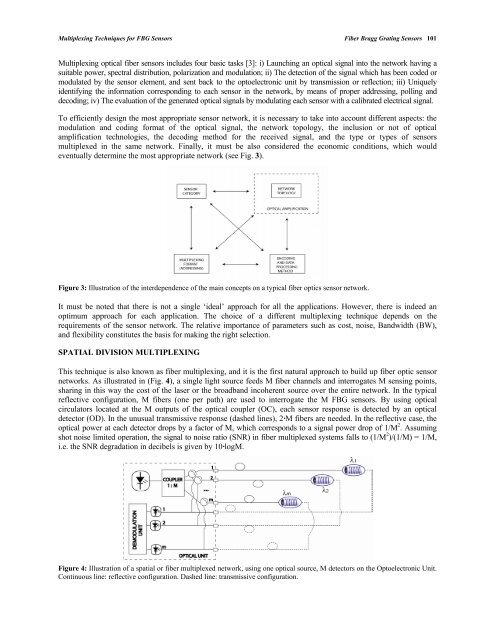chapter 1 - Bentham Science
chapter 1 - Bentham Science
chapter 1 - Bentham Science
Create successful ePaper yourself
Turn your PDF publications into a flip-book with our unique Google optimized e-Paper software.
Multiplexing Techniques for FBG Sensors Fiber Bragg Grating Sensors 101<br />
Multiplexing optical fiber sensors includes four basic tasks [3]: i) Launching an optical signal into the network having a<br />
suitable power, spectral distribution, polarization and modulation; ii) The detection of the signal which has been coded or<br />
modulated by the sensor element, and sent back to the optoelectronic unit by transmission or reflection; iii) Uniquely<br />
identifying the information corresponding to each sensor in the network, by means of proper addressing, polling and<br />
decoding; iv) The evaluation of the generated optical signals by modulating each sensor with a calibrated electrical signal.<br />
To efficiently design the most appropriate sensor network, it is necessary to take into account different aspects: the<br />
modulation and coding format of the optical signal, the network topology, the inclusion or not of optical<br />
amplification technologies, the decoding method for the received signal, and the type or types of sensors<br />
multiplexed in the same network. Finally, it must be also considered the economic conditions, which would<br />
eventually determine the most appropriate network (see Fig. 3).<br />
Figure 3: Illustration of the interdependence of the main concepts on a typical fiber optics sensor network.<br />
It must be noted that there is not a single ‘ideal’ approach for all the applications. However, there is indeed an<br />
optimum approach for each application. The choice of a different multiplexing technique depends on the<br />
requirements of the sensor network. The relative importance of parameters such as cost, noise, Bandwidth (BW),<br />
and flexibility constitutes the basis for making the right selection.<br />
SPATIAL DIVISION MULTIPLEXING<br />
This technique is also known as fiber multiplexing, and it is the first natural approach to build up fiber optic sensor<br />
networks. As illustrated in (Fig. 4), a single light source feeds M fiber channels and interrogates M sensing points,<br />
sharing in this way the cost of the laser or the broadband incoherent source over the entire network. In the typical<br />
reflective configuration, M fibers (one per path) are used to interrogate the M FBG sensors. By using optical<br />
circulators located at the M outputs of the optical coupler (OC), each sensor response is detected by an optical<br />
detector (OD). In the unusual transmissive response (dashed lines), 2·M fibers are needed. In the reflective case, the<br />
optical power at each detector drops by a factor of M, which corresponds to a signal power drop of 1/M 2 . Assuming<br />
shot noise limited operation, the signal to noise ratio (SNR) in fiber multiplexed systems falls to (1/M 2 )/(1/M) = 1/M,<br />
i.e. the SNR degradation in decibels is given by 10·logM.<br />
Figure 4: Illustration of a spatial or fiber multiplexed network, using one optical source, M detectors on the Optoelectronic Unit.<br />
Continuous line: reflective configuration. Dashed line: transmissive configuration.

















